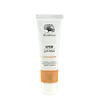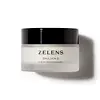What's inside
What's inside
 Key Ingredients
Key Ingredients

 Benefits
Benefits

 Concerns
Concerns

 Ingredients Side-by-side
Ingredients Side-by-side

Water
Skin ConditioningMacadamia Ternifolia Seed Oil
EmollientCaprylic/Capric Triglyceride
MaskingCetearyl Glucoside
EmulsifyingPhospholipids
Skin ConditioningSphingolipids
EmollientMangifera Indica Seed Butter
Skin ConditioningOryza Sativa Bran Oil
EmollientTriticum Vulgare Germ Oil
EmollientSodium PCA
HumectantGlycerin
HumectantBeeswax
Emulsion StabilisingLecithin
EmollientBehenyl Alcohol
EmollientCetearyl Alcohol
EmollientLinoleic Acid
CleansingLinolenic Acid
CleansingTrehalose
HumectantBenzyl Alcohol
PerfumingPanthenol
Skin ConditioningGlycine Soja Oil
EmollientGlycolipids
Skin ConditioningGlycine Soja Sterols
EmollientGlyceryl Laurate
EmollientTocopherol
AntioxidantHippophae Rhamnoides Fruit Extract
Skin ConditioningChamomilla Recutita Flower Extract
MaskingLavandula Angustifolia Flower Extract
CleansingTilia Cordata Extract
RefreshingSalvia Officinalis Leaf Extract
CleansingXanthan Gum
EmulsifyingBeta-Sitosterol
Emulsion StabilisingSqualene
EmollientWater, Macadamia Ternifolia Seed Oil, Caprylic/Capric Triglyceride, Cetearyl Glucoside, Phospholipids, Sphingolipids, Mangifera Indica Seed Butter, Oryza Sativa Bran Oil, Triticum Vulgare Germ Oil, Sodium PCA, Glycerin, Beeswax, Lecithin, Behenyl Alcohol, Cetearyl Alcohol, Linoleic Acid, Linolenic Acid, Trehalose, Benzyl Alcohol, Panthenol, Glycine Soja Oil, Glycolipids, Glycine Soja Sterols, Glyceryl Laurate, Tocopherol, Hippophae Rhamnoides Fruit Extract, Chamomilla Recutita Flower Extract, Lavandula Angustifolia Flower Extract, Tilia Cordata Extract, Salvia Officinalis Leaf Extract, Xanthan Gum, Beta-Sitosterol, Squalene
Water
Skin ConditioningGlycerin
HumectantBehenyl Alcohol
EmollientCoco-Caprylate/Caprate
EmollientGlyceryl Stearate
EmollientDimethicone
EmollientPanthenyl Triacetate
Ethyl Linoleate
EmollientTrehalose
HumectantLinoleic Acid
CleansingLinolenic Acid
CleansingOleic Acid
EmollientCeramide Ns
Skin ConditioningPhospholipids
Skin ConditioningMethyl Cyclodextrin
7-Dehydrocholesterol
Emulsion StabilisingGlycolipids
Skin ConditioningGlycine Soja Sterols
EmollientPerilla Frutescens Leaf Extract
MaskingAlpha-Glucan Oligosaccharide
CleansingPolymnia Sonchifolia Root Juice
Skin ConditioningTocopherol
AntioxidantPropanediol
SolventOrnithine
Skin ConditioningSaccharomyces Ferment Lysate Filtrate
Skin ConditioningCholesterol
EmollientLactobacillus
Skin ConditioningPalmitic Acid
EmollientStearic Acid
CleansingLecithin
EmollientInulin Lauryl Carbamate
Emulsion StabilisingHydrogenated Lecithin
EmulsifyingBenzyl Alcohol
PerfumingCarbomer
Emulsion StabilisingSodium Dehydroacetate
PreservativeLauryl Alcohol
EmollientLevulinic Acid
PerfumingP-Anisic Acid
MaskingSodium Hydroxide
BufferingMyristyl Alcohol
EmollientCetyl Alcohol
EmollientOleyl Alcohol
EmollientDehydroacetic Acid
PreservativeOctyldodecanol
EmollientMaltodextrin
AbsorbentCitric Acid
BufferingSodium Benzoate
MaskingPotassium Sorbate
PreservativeWater, Glycerin, Behenyl Alcohol, Coco-Caprylate/Caprate, Glyceryl Stearate, Dimethicone, Panthenyl Triacetate, Ethyl Linoleate, Trehalose, Linoleic Acid, Linolenic Acid, Oleic Acid, Ceramide Ns, Phospholipids, Methyl Cyclodextrin, 7-Dehydrocholesterol, Glycolipids, Glycine Soja Sterols, Perilla Frutescens Leaf Extract, Alpha-Glucan Oligosaccharide, Polymnia Sonchifolia Root Juice, Tocopherol, Propanediol, Ornithine, Saccharomyces Ferment Lysate Filtrate, Cholesterol, Lactobacillus, Palmitic Acid, Stearic Acid, Lecithin, Inulin Lauryl Carbamate, Hydrogenated Lecithin, Benzyl Alcohol, Carbomer, Sodium Dehydroacetate, Lauryl Alcohol, Levulinic Acid, P-Anisic Acid, Sodium Hydroxide, Myristyl Alcohol, Cetyl Alcohol, Oleyl Alcohol, Dehydroacetic Acid, Octyldodecanol, Maltodextrin, Citric Acid, Sodium Benzoate, Potassium Sorbate
Ingredients Explained
These ingredients are found in both products.
Ingredients higher up in an ingredient list are typically present in a larger amount.
Behenyl Alcohol is a type of fatty alcohol (these are different from the drying, solvent alcohols).
Fatty Alcohols have hydrating properties and are most often used as an emollient or to thicken a product. They are usually derived from natural fats and oils; behenyl alcohol is derived from the fats of vegetable oils.
Emollients help keep your skin soft and hydrated by creating a film that traps moisture in.
In 2000, Behenyl Alcohol was approved by the US as medicine to reduce the duration of cold sores.
Learn more about Behenyl AlcoholBenzyl Alcohol is most commonly used as a preservative. It also has a subtle, sweet smell. Small amounts of Benzyl Alcohol is not irritating and safe to use in skincare products. Most Benzyl Alcohol is derived from fruits such as apricots.
Benzyl Alcohol has both antibacterial and antioxidant properties. These properties help lengthen the shelf life of products. Benzyl Alcohol is a solvent and helps dissolve other ingredients. It can also improve the texture and spreadability.
Alcohol comes in many different forms. Different types of alcohol will have different effects on skin. This ingredient is an astringent alcohol.
Using high concentrations of these alcohols are drying on the skin. They may strip away your skin's natural oils and even damage your skin barrier. Astringent alcohols may also irritate skin.
Other types of astringent alcohols include:
According to the National Rosacea Society based in the US, you should be mindful of products with these alcohols in the top half of ingredients.
Any type of sanitizing product will have high amounts of alcohol to help kill bacteria and viruses.
Learn more about Benzyl AlcoholGlycerin is already naturally found in your skin. It helps moisturize and protect your skin.
A study from 2016 found glycerin to be more effective as a humectant than AHAs and hyaluronic acid.
As a humectant, it helps the skin stay hydrated by pulling moisture to your skin. The low molecular weight of glycerin allows it to pull moisture into the deeper layers of your skin.
Hydrated skin improves your skin barrier; Your skin barrier helps protect against irritants and bacteria.
Glycerin has also been found to have antimicrobial and antiviral properties. Due to these properties, glycerin is often used in wound and burn treatments.
In cosmetics, glycerin is usually derived from plants such as soybean or palm. However, it can also be sourced from animals, such as tallow or animal fat.
This ingredient is organic, colorless, odorless, and non-toxic.
Glycerin is the name for this ingredient in American English. British English uses Glycerol/Glycerine.
Learn more about GlycerinGlycine Soja Sterols is derived from the soybean plant. Sterols are an organic compound and technically an alcohol.
Unlike solvent alcohols, glycine soja sterols have emollient properties and help hydrate the skin.
This ingredient may not be Malassezia folliculitis, or fungal-acne safe.
Sterols can be found in plants, animals, and fungi.
Learn more about Glycine Soja SterolsGlycolipids are natural, sustainable biosurfactants. They are both surfactants (cleansing agents) and emollients.
Made from lipids and sugars, in-vitro studies show glycolipids are a gentle alternative to conventional surfactants. They also possess foaming properties to give cleaning products a nice texture.
One manufacturer study found their glycolipid also demonstrated sebum reduction and helped reduced oiliness after four weeks. This means it can also be great for scalp care.
Learn more about GlycolipidsLecithin is a term for a group of substances found in the cell membranes of plants, animals, and humans. They are made up of mixture of phospholipids.
This ingredient has emollient and emulsifying properties.
As an emollient, lecithen helps soften the skin and creates a barrier to keep moisture in.
As an emulsifier, it also helps prevent water and oil ingredients from separating. Lecithin can also help ingredients be better absorbed by the skin.
This is because the phospholipids in lecithin produce liposomes. Liposomes help other ingredients get through the skin barrier.
Depending on the source of this ingredient, lecithin may not be fungal acne safe. This is because some sources of lecithin come from soybean oil, which may feed the malassezia yeast that feeds fungal acne.
We recommend reaching out to the brand you are purchasing from to inquire about the source of their lecithin.
Some other names for this ingredient include soy lecithin and deoiled soy lecithin.
Learn more about LecithinLinoleic Acid is also known as Vitamin F. It is a fatty acid with emollient and skin conditioning properties. Our top layer of skin, or epidermis, contains high amounts of linoleic acid naturally.
Your body uses linoleic acid to build ceramides and prostaglandins. Ceramides keep your skin's barrier hydrated and strong while prosaglandins help control inflammation and healing. Needless to say, linoleic acid is crucial for having a strong skin barrier.
One study found applying linoleic acid rich sunflower oil to be more effective at repairing the skin barrier than oleic rich olive oil.
Linoleic acid is an essential fatty acid, meaning our bodies cannot create it on its own. We need to get linoleic acid through foods such as nuts and vegetable oils.
Acne-prone skin tends to have linoleic acid and high levels of oleic acid.
Linoleic acid can also help treat acne by softening sebum to prevent clogged pores. Another study found using 2.5% linoleic acid gel for 4 weeks showed a 25% reduction in small comedones.
This ingredient can also help lighten hyperpigmentation or sun spots by disrupting the melanin production process. It also helps your skin shed melanin pigment from your skin caused by UV exposure.
Due to its role in the production of the fatty acid prostaglandin, linoleic acid can also help reduce inflammation and support wound healing.
Linoleic acid is not always fungal-acne safe; it may trigger flare-ups in sensitive individuals.
Learn more about Linoleic AcidLinolenic Acid is also known as "ALA" or alpha-linolenic acid. It is a fatty acid used to hydrate skin and hair.
This ingredient can help with soothing irritated skin and reducing hyperpigmentation by disrupting the melanin production process.
Fun fact: This ingredient is considered an essential fatty acid for humans. This means our bodies cannot naturally produce it and we must get it from food.
Some foods rich in linolenic acid include: walnuts, fish oils, soy, and canola.
A deficiency in linolenic acid may be linked to skin disorders like eczema.
Another essential fatty acid is Linoleic Acid.
Learn more about Linolenic AcidPhospholipids are naturally found in our skin as they are the main component of cell membranes. Phospholipids have humectant, emollient, antioxidant properties.
Phospholipids are complex lipids that contain glycerin, two fatty acids, and a phosphate group. Some foods that contain phospholipids include soybeans and milk. The phospholipids found in soy come from Lecithin. This ingredient can also be synthetically created.
Due to their hygroscopic nature, they act as both humectants and emollients. Humectants draw moisture from the air to your skin, while emollients help trap moisture in.
The phospholipids in our skin can be naturally depleted. Replenishing the phospholipids in our skin can help hydrate your skin.
Studies show phospholipids display antioxidant activity and may help with reducing the signs of aging.
This ingredient is non-occlusive.
Some types of phospholipids:
Learn more about PhospholipidsTocopherol (also known as Vitamin E) is a common antioxidant used to help protect the skin from free-radicals and strengthen the skin barrier. It's also fat soluble - this means our skin is great at absorbing it.
Vitamin E also helps keep your natural skin lipids healthy. Your lipid skin barrier naturally consists of lipids, ceramides, and fatty acids. Vitamin E offers extra protection for your skin’s lipid barrier, keeping your skin healthy and nourished.
Another benefit is a bit of UV protection. Vitamin E helps reduce the damage caused by UVB rays. (It should not replace your sunscreen). Combining it with Vitamin C can decrease sunburned cells and hyperpigmentation after UV exposure.
You might have noticed Vitamin E + C often paired together. This is because it is great at stabilizing Vitamin C. Using the two together helps increase the effectiveness of both ingredients.
There are often claims that Vitamin E can reduce/prevent scarring, but these claims haven't been confirmed by scientific research.
Learn more about TocopherolTrehalose is a disaccharide made of two glucose molecules (glucose is sugar!). Trehalose is used to help moisturize skin. It also has antioxidant properties.
As a humectant, trehalose helps draw moisture from the air to your skin. This helps keep your skin hydrated.
Due to its antioxidant properties, trehalose may help with signs of aging. Antioxidants help fight free-radical molecules, unstable molecules that may damage your skin.
In medicine, trehalose and hyaluronic acid are used to help treat dry eyes.
Some animals, plants, and bacteria create trehalose as a source of energy to survive freeze or lack of water.
Learn more about TrehaloseWater. It's the most common cosmetic ingredient of all. You'll usually see it at the top of ingredient lists, meaning that it makes up the largest part of the product.
So why is it so popular? Water most often acts as a solvent - this means that it helps dissolve other ingredients into the formulation.
You'll also recognize water as that liquid we all need to stay alive. If you see this, drink a glass of water. Stay hydrated!
Learn more about Water